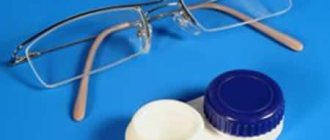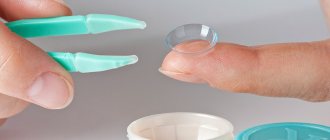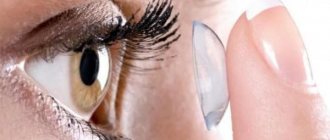Today, contact lenses are extremely popular. They have successfully replaced glasses and effectively correct myopia and farsightedness, astigmatism and presbyopia. They are also used for decorative purposes - to change or emphasize eye color. When and by whom were lenses invented?
At all times there have been people with poor eyesight. Of course, in recent years this problem has become global in connection with the development of information technology. Today it’s difficult to surprise anyone with a computer, tablet or e-reader. It is not surprising that the visual functions of modern people begin to deteriorate due to prolonged exposure to the eyes, which requires the constant use of glasses or contact lenses. However, people faced similar problems in ancient centuries, but the reason for the decline in visual acuity was not computers and televisions. When did the first lenses appear?
Prerequisites for creating lenses
It's hard to believe that the very first mention of contact lenses belongs to the famous artist Leonardo da Vinci. It dates back to 1508 and is found in the book “The Code of the Eye”. It was da Vinci who created the drawing of future lenses. The image was a glass sphere filled with water, thanks to which a person with poor eyesight could better see surrounding objects. However, it cannot be said that Leonardo da Vinci was the creator of the very first model of contact lenses. Rather, he paid attention to the existing refractions of light that enters the eyes. It was the mention of the artist that served as an incentive for his followers to invent lenses. One of them was the French philosopher, mathematician and physicist Rene Descartes. In 1632, he first put a glass container filled with water over his eyes, because this is how da Vinci described future contact lenses. However, it was impossible to wear such an invention. Firstly, it was completely inconvenient to use and significantly constrained the movements of its owner. Secondly, correcting vision with their help was quite difficult, since a container filled with water quickly fogged up, thereby further worsening visual functions. Thirdly, the use of such lenses prevented a person from blinking, thus disrupting natural physiological processes and contributing to the drying out of the cornea.
Contact lenses. From Leonardo da Vinci to modern times
Ordinary objects that are used by millions of people every day can be truly surprising if you look into the history of their creation. For example, the first sketches of eye lenses were drawn by the same hand as the main masterpiece of the Louvre - the Mona Lisa.
A brilliant person is a genius in everything
Researchers of the works of Leonardo da Vinci discovered sketches of an optical instrument dating back to 1508 in his notes. It is an enlarged eye structure and consists of two spheres, one of which is filled with water to refract the image, and the second has a darkening zone and an area for focusing the image. But, like many other inventions of da Vinci, the project remained on paper and in the imagination of the genius. Surely the scientist would be delighted with how his idea was transformed over 510 years and turned into modern contact lenses for the eyes.
Implementation of ideas
Another famous scientist and philosopher was noted in the history of the creation of lenses - Rene Descartes. 128 years after Leonardo, he proposed using a viewing tube filled with water with a lens at the end to improve vision. And again the idea stopped at the design and development stage, which Thomas Young undertook to implement only in 1801. The invention, called a hydroscope, did not receive recognition, again being ahead of its time.
British scientist John Herschel made a significant contribution to the theoretical part of the development of contact lenses. He described a design of two glass spheres with a gelatin-filled space intended for vision correction. In his works, he paid special attention to the aspects of neutralizing spherical and chromatic aberration. Since 1957, the Herschel Medal has been awarded for outstanding achievements in the field of vision correction with contact lenses.
Get to the point
Glasses, monocles and strange vision correction devices that were attached to hats did not stop inventors from trying to create a lens that would be mounted directly on the cornea. Only in 1888 did the German ophthalmologist Adolf Fick succeed in this after a series of experiments on rabbits, himself and volunteers. In parallel with him, the Frenchman Eugene Calt worked on the development of lenses for the correction of keratoconus; he made his first lenses from the bottoms of test tubes. And another very myopic scientist, August Müller, was personally interested in the invention of comfortable and reliable lenses, because he had high myopia -14 diopters.
The right contact lenses
After another two hundred years, the British physicist and astronomer John Herschel returned to the topic of creating contact lenses. It was he who described in detail in his writings what a real and, most importantly, correct contact lens should look like.
Herschel called its most important characteristic the ability to repeat the shape of the eye. Today, each of us understands that this particular feature is the main one for lenses, but in those days, it was quite difficult for scientists to understand exactly what contact lens models that could not only correct visual impairments, but also remain comfortable to wear should actually look like for any user.
Contact lens care products
Contact lens care products include solutions and rewetting drops.[14]
Contact lens care solutions perform the following functions: cleaning, moisturizing, disinfecting, storing lenses.
Types of solutions:
- Multifunctional solution is the most common way to care for contact lenses. It can be used to clean, store and disinfect contact lenses.
- The peroxide solution contains hydrogen peroxide, which has strong disinfectant properties. When caring for lenses, hydrogen peroxide must be neutralized using a special container or tablets. Such solutions should not be used to rinse lenses before putting them on or drop them into the eyes. This may cause a burning sensation. Suitable for all types of soft and hard contact lenses. Peroxide solutions do not contain preservatives.
For additional care of contact lenses, enzymatic (enzymatic) cleaners in the form of solutions or tablets can be used.[15]
The first glass lenses
Who developed the very first glass lens? This person was the German glassblower Friedrich Müller, and this memorable event in the field of ophthalmology took place in 1888. Müller did not set out to create a contact lens. He just wanted to help his close friend see the world around him in bright colors. It so happened that a friend lost an eyelid. Why this happened is unknown, but the fact remains. Moreover, Müller did not seek to develop optical products that could correct vision. The friend, who was left without an eyelid, repeatedly complained to Friedrich that the mucous membrane of the eye quickly dried out, causing his vision to become blurred. Nobody used contact lenses in those days, and therefore this method of correction remained unexplored until the end.
Muller positioned his invention as protecting the eye from the negative effects of the environment.
Having thus developed the first lenses, the glassblower devoted himself to further creating similar models, but this time intended for a wide range of clients. The lenses he created completely followed the shape of the eye and were two-color. The white part was adjacent directly to the eye sclera, and the transparent part was adjacent to the iris and pupil.
When did lenses appear on the optical market?
The very first lenses to go into mass production were created by the famous German brand Carl Zeiss. Although calling him famous would not be entirely true. At that time, the company had just appeared on the market and was actively engaged in the production of microscopes. The founder of the company, Karl Zeiss, considered it his duty to continue the work begun by his fellow countryman, the German glassblower Friedrich Müller. Zeiss managed to give the contact lens the desired shape so that it could follow the shape of the human eye. The difficulty was that the lenses he produced were of the same size, because they were all manufactured by specialists from his company using the same equipment. However, the problem with identically manufactured lenses was soon solved. This was facilitated by Carl Zeiss’ acquaintance with Otto Schott, a German chemist specializing in the production of glass products.
Together they managed to create lenses that, although slightly different from each other in size, allowed many people to correct their vision with contact lenses.
Carl Zeiss and Otto Schott
Plastic lenses
The next stage in the history of optical products was the unique discovery of the Hungarian doctor Istvan Gyorfi. He managed to develop a lens made of plastic. It is not at all surprising that most people were quite uncomfortable with glass lenses. Many of them complained of discomfort and pain in the eyes when using them, and children were completely prohibited from wearing them. However, the lens, made of plastic, was also not ideal. The material used in its creation was called Plexiglas and was characterized by increased rigidity, which also caused inconvenience during operation, albeit not for such a large number of people. Despite this, Györffy received a patent for the production of contact lenses developed on the basis of Plexiglas.
At first sight
Emerald lenses
The first lenses appeared in ancient times, but only fragmentary mentions of their use have reached us. Pliny the Elder, for example, wrote that Nero looked through a specially cut emerald during gladiatorial fights. Ptolemy discussed the use of a convex lens to obtain an enlarged image in his treatise “Optics”.
First glasses
Scientists do not know for sure who invented the world's first real glasses. They are believed to have been invented in Italy at the end of the 13th century, probably in Pisa. In 1306, the Dominican friar Giordano de Pisa said during his sermon: “Not even 20 years have passed since the art of making glasses to improve vision was discovered. This is one of the best and most necessary arts in the world. How little time has passed since a new art that never existed was invented. I saw the man who first created glasses, and I talked with him." According to this theory, Alessandro Spina was the first to produce glasses. By 1301, rules regulating the sale of glasses had already appeared in Venice. Marco Polo claimed that he saw glasses during his travels in China. But most likely, the first glasses appeared in Asia only in the 15th century and were imported from Europe.
Fragment of a fresco by Tomaso da Modena from the Church of Treviso
The first glasses consisted of two lenses connected by a wooden, bone or metal frame. They didn't have temples, so you had to hold the glasses with your hands. In the 16th century, pince-nez appeared, which were held on the nose thanks to a spring. The idea of tying strings to the ears and securing the glasses in this way led to the appearance of a rigid bridge on the bridge of the nose between the lenses. A little later, arms were attached to them. So the glasses took on their familiar appearance. Modern ones, of course, are much better than medieval ones - they are created using lenses made of polymer materials, which are lighter, more convenient and stronger than conventional ones. In addition, you can choose lenses with protective coatings and filters, and progressive lenses allow you to correct vision at various distances.
The first contact lenses
The glasses, however, were not without drawbacks - their owner could not move completely freely. Then people thought about the contact method of correcting vision. The first person to express such an idea was Leonardo da Vinci. In his archives, drawings were found of a ball filled with water, through which a person could see better. Rene Descartes also carried out similar research. He designed a device consisting of a glass tube filled with water. A magnifying glass was attached to one end of the tube, and the other was applied to the eye. At the end of the 19th century, the German physiologist Adolph Gaston described the first glass lens with optical power. And a year later it was manufactured and used in medical practice by the German scientist August Muller. Until the mid-20th century, lenses were made from organic glass, which was uncomfortable to wear. In the early 60s, Czech scientist Otto Wichterle created the first soft contact lens. And only at the beginning of the 21st century, silicone hydrogel lenses appeared in production, which do not cause discomfort when worn.
Drawing by Leonardo da Vinci demonstrating the working principle of contact lenses
From accident to cataract treatment
Neither glasses nor contact lenses, however, could help with serious visual impairment associated with eye diseases, for example, with clouding of the lens of the eye (cataract). Patients complain of a veil before the eyes, which interferes with vision both far and near. Visual acuity decreases sharply, and glasses no longer help. Photosensitivity increases, color perception is impaired - the world around seems dimmer. If cataracts are not treated promptly, it can lead to complete blindness.
Previously, the patient had his clouded lens removed, and then prescribed glasses with such thick lenses that it was difficult for him to hold his head straight. However, these procedures could not truly restore a person's vision. A real breakthrough in ophthalmology was made by the British surgeon Harold Ridley, who invented the artificial lens.
Harold Ridley
Ridley's discovery is connected with the tragic history of the Second World War. Pilot Gordon Cleaver jumped into a plane during one of the Luftwaffe raids, forgetting to put on his safety glasses. One of the German shells shattered the plexiglass canopy of his cockpit, and the fragments instantly blinded Cleaver. He performed a half roll blindly, fell out of the cockpit, released his parachute and landed on the ground. His face and eyes were cut by shards of plexiglass. The almost hopeless operation was undertaken by surgeon Harold Ridley, who even restored sight to the pilot in his right eye. During the operation, Ridley noticed that the plexiglass fragments did not cause any irritation or suppuration. Probably, the tissues of the eye did not reject the plexiglass. One of Ridley's students, having learned about this case, suggested replacing the real lens with an artificial one made of plexiglass. The surgeon was inspired by the idea and, together with his optician friend John Pike, made the world's first artificial lens.
Boycott instead of Nobel Prize
Now the lens had to be implanted into a person with cataracts in one eye. 45-year-old nurse Elizabeth Atwood agreed to the experiment. The operation was performed in 1950. Ridley filmed it and kept it secret so he could make sure the invention was harmless. But one of Ridley's patients mixed up the numbers in the phone book and made an appointment with another surgeon for a routine examination. The colleague, of course, understood everything, and the Englishman had to declassify. He did not patent the invention, he only wrote an article about it to claim priority. But the British ophthalmologist Duke-Elder decided that he should also have been listed as the author of the article and was offended by Ridley. So when a hopeful researcher arrived at the Oxford Ophthalmological Congress with a patient he had helped restore to perfect vision, his colleagues boycotted him. Instead of awards, Ridley received a nervous breakdown and was forced to undergo treatment in a psychiatric clinic for 30 years. Only in 2000 did he finally receive the recognition he deserved. Queen Elizabeth II knighted him.
First operation in the USSR
Ridley's article was noticed by scientists in the USSR. The head of the Cheboksary branch of the Helmholtz Institute, Svyatoslav Fedorov, decided to try to implant an artificial lens into a rabbit. The experiment was successful, and Fedorov performed surgery on the eye of a 12-year-old girl, Lena Petrova, who had had cataracts since she was two years old. The artificial lens took root, but in fact the surgeon acted at his own peril and risk, because all the instruments used were still unfinished.
Lena Petrova, Fedorov's first patient
Modern treatment of cataracts using artificial lenses
Many years have passed since the first implantation of artificial lenses, and today cataract surgery with implantation of an artificial lens is high-tech and safe. Nowadays, cataracts are removed using phacoemulsification through a tiny 2 mm puncture. The damaged lens is crushed using ultrasound and its fragments are removed. An artificial lens is implanted into the freed space. Modern implants are very elastic, which allows them to be implanted through very small incisions. And the accuracy of selecting optical characteristics up to 0.5 diopters Ridley could not even dream of. The latest technologies even make it possible to create “multifocal” vision, when the patient is able to see equally clearly at both long and close distances.
One of the leaders in the field of cataract treatment with implantation of an artificial lens is Family Ophthalmology Clinic of Professor Trubilin
Professor Trubilin at one time worked under the guidance of Academician S.N. Fedorov, who carried out the first such operation in the USSR, and was his student.
Today he heads the Russian Society of Cataract and Refractive Surgeons, being one of the leaders in this area in ophthalmology. In addition to cataract removal, the “Professor Trubilin Family Ophthalmology Clinic” also diagnoses and treats myopia, farsightedness and astigmatism, glaucoma, pathology of the retina and optic nerve
. The clinic can select and manufacture any types of glasses and contact lenses, as well as perform laser vision correction.
Who invented soft lenses?
When did soft lenses appear and who is their creator? The first soft material was used by the Czech scientist Otto Wichterle. For several years he worked at the research institute of one of the country's shoe companies, being the head of the department for processing polyamide and plastics. Few people know that lenses were preceded by the creation of silicone, the material from which soft models began to be created. Wichterle managed to develop this polymer in the following way. Interested in organic chemistry, Otto developed a method for winding polyamide thread onto a spool. It was called silicone. Then he became interested in the synthesis of polymer materials. He tried to understand which material was best suited for the production of contact lenses. So he managed to develop a hydrogel that could absorb about 40% of water. It was completely transparent and had all the necessary properties.
In the mid-50s of the last century, the material was patented, after which Otto Wichterle received a patent for further production of lenses.
Who invented the Lens - When was it invented?
In school physics lessons we remember that light rays travel in a straight line. Any object in their path partially absorbs light and partially reflects it at the same angle at which it falls. The only exception is when light passes through a transparent object. At the boundary of two transparent media of different densities (for example, air and water or glass), light rays are refracted to a greater or lesser extent, and amazing optical effects arise, depending on the physical characteristics of the object through which the light passes.
This property of light allows you to control the course of rays, changing their direction or turning a diverging beam of rays into a converging one, and vice versa. In practice, this can be achieved using specially processed devices made of optically transparent homogeneous material, which are called lenses (lat. lens “lentils”). Looking at an object through lenses with different physical and chemical characteristics, we will see it upright or inverted, enlarged or reduced, clear or distorted.
The simplest lens is a carefully ground and polished piece of a highly transparent substance (glass, plastic, mineral), limited by two refractive surfaces, two spherical or flat and spherical (although there are lenses with more complex aspherical surfaces). Lenses whose middle is thicker than the edges are called converging (positive), diverging (negative) are called lenses whose edges are thicker than the middle. A positive lens has the ability to collect rays incident on it at one point located on the other side of it, at focus. A negative lens, on the contrary, deflects rays passing through it towards the edges.
The simplest rock crystal lens.
Although the scope of use of lenses in science and technology is very large, their main functions boil down to a few basic ones. This is the accumulation of thermal energy of light rays, visual approximation and magnification of small or distant objects, as well as vision correction because the lens of the eye by its nature is a lens with variable curvature of surfaces. People began to use some properties of lenses earlier, others later, nevertheless, these optical devices have been known to them since ancient times.
There are different opinions about when people learned to create fire using sunlight and polished pieces of transparent stone or glass with a convex surface. We can say for sure that this method was known in Ancient Greece in the middle of the 1st millennium BC. e., since it is described in Aristophanes’ play “The Clouds”. However, lenses made of rock crystal, quartz, precious and semi-precious stones found during excavations are much older. One of the most ancient lenses, the so-called god with glasses, was discovered during excavations of Uruk, an ancient city-state in Mesopotamia. The age of this lens is about 6 thousand years, but its purpose remains a mystery.
In Egypt during the IV-XIII dynasties (III-II millennium BC), crystal lenses were used for... models of eyes in statues. Optometric studies have shown that models are very close to the actual shape and optical qualities of the eye, and sometimes even show visual impairments such as astigmatism.
Alabaster “idols with eyes.” Tel Brak site, Syria. IV millennium BC e.
Unfortunately, over time, the secret of making such lenses was lost; the false eyes of statues began to be made of stone or faience. The “glass eyes” technique, although with less perfection, was also used by the ancient Greeks. For example, bronze statues of the 5th century were equipped with lenses. BC e., discovered in the sea off the coast of Calabria. But there were still many centuries left before the “official” discovery of the optical properties of the eye!
During excavations in Mesopotamia, Greece and Etruria, a considerable number of crystal lenses dating back to approximately the end of the 1st millennium BC were discovered. e. A study of their decoration showed that the lenses were used both for visual magnification and as decoration. Essentially, these were true magnifying glasses with a short focal length that increased the angle of view. In addition, miniature gems were found in Greece, connected by a frame with convex lenses; these gems would not be possible to produce without optical magnification of the working field. All this indicates that magnifying glasses began to be used long before the magnifying effect of lenses was recorded in scientific sources.
When exactly lenses began to be used for vision correction has not yet been established. There is an opinion, however, not supported by anything, that lenses discovered during excavations of ancient Troy were used precisely for this purpose. In the works of the Roman historian of the 1st century. Pliny the Elder mentions that Emperor Nero, who suffered from myopia, watched gladiatorial fights through a concave lens carved from emerald, this was a kind of prototype of glasses. Some historians, based on ancient engravings, believe that glasses were invented in China in the 7th-9th centuries, but whether they were optical or sunglasses is unknown.
An Arab scientist of the 9th century was the first to seriously study the eye as an optical system. Abu Ali al-Hasan, known in Europe as Al-Khazen. In his fundamental work, The Book of Optics, he relied on the research of a Roman physician of the 2nd century. Galena. Al-Hasan described in detail how an image of an object is created on the retina of the eye using the lens. However, the essence of myopia, farsightedness and other vision defects, in which the focus of the lens shifts relative to the retina, was finally clarified only in the 19th century, and before that, glasses were selected virtually at random until the desired effect was achieved.
Mysterious optics
On the Swedish island of Gotland, in a treasure buried about a thousand years ago by the Vikings, lenses of complex aspherical shape made of rock crystal were found. This form of lenses was theoretically calculated only in the 17th century. Rene Descartes. In his work, he indicated that these lenses would give an excellent image, but for a long time not a single optician could produce them. It remains a mystery who could have polished the lenses from the Viking treasure and for what purposes.
Seller of glasses. Engraving after a painting by Giovanni Stradano. XVI century
It is believed that glasses were invented in Italy at the end of the 13th century, their invention is attributed to the monk Alessandro Spina or another monk Salvino D'Armata. The first documentary evidence of the existence of glasses dates back to 1289, and their first image was discovered in the Church of Treviso on a fresco painted in 1352 by the monk Tommaso da Modena. Until the 16th century Glasses were used only for farsightedness, then glasses with concave lenses appeared for nearsightedness. Over time, the shape of the glasses changed and the frame and arms appeared. In the 19th century Benjamin Franklin invented bifocal lenses, which have the upper part for distance use and the lower part for near work.
J.B. Chardin. Self-portrait with glasses. 1775
Jan van Eyck. Madonna and Child with Canon Joris van der Paele. Fragment. 1436
Photochromic lenses (“chameleons”) were created in 1964 by Corning specialists. These were glass lenses, the photochromic properties of which were given by salts of silver and copper. Polymer lenses with photochromic properties appeared in the early 1980s, but due to significant disadvantages, low darkening and lightening rates, as well as extraneous color shades, were not widely used. In 1990, Transition optical released more advanced plastic photochromic lenses, which gained enormous popularity.
Contact lenses are considered a relatively young invention, but Leonardo da Vinci worked on their device. Many scientists thought about how to put a lens directly on the eyeball, but only in 1888 did the Swiss ophthalmologist Adolf Fick describe the structure of a contact lens and begin experiments. Mass production of contact lenses was started in Germany by the famous optical company Carl Zeiss. The first samples were completely glass, quite large and heavy. In 1937, lenses made of polymethyl methacrylate appeared. In 1960, Czechoslovak scientists Otto Wichterle and Dragoslav Lim synthesized a new polymer material, HEMA, developed a method of rotational polymerization, and produced soft contact lenses. At the same time, hydrogel lenses were developed in the USA.
As for the magnifying power of single lenses, it soon became clear that it was limited, since increasing the convexity of the lens led to image distortion. But if you place two lenses in succession between the eye and the object (eyepiece and objective), the magnification will become much greater. Using the lens at the focal point, an actual image of the observed object is created, which is then magnified by the eyepiece, which acts as a magnifying glass. The invention of the microscope (from the Greek mikros “small” and skopeo “I look”) is associated with the names of the Dutch John Lippershey and the father and son Jansen (late 16th century). In 1624, Galileo Galilei created his compound microscope. The first microscopes provided magnification up to 500 times, while modern optical microscopes can achieve 2000 times magnification.
Simultaneously with the first microscopes, telescopes (or spyglasses) appeared (their invention is attributed to the Dutch Zacharias Jansen and Jacob Metius, although the first attempts to look at stars using lenses were made by Leonardo da Vinci). The first person to point a telescope into the sky, turning it into a telescope (from the Greek tele, “far”), was Galileo. The principle of operation of an optical telescope is the same as that of a microscope, the only difference is that the lens of the microscope gives an image of a nearby small body, and a telescope of a distant large body. However, since the end of the 17th century, telescopes have used a concave mirror as a lens.
Otto Wichterle in the laboratory.
Among other things, lenses are used in the field of photography, film, television and video, as well as for the projection of finished images. The lens of a camera and similar equipment is an optical system of several lenses, sometimes in combination with mirrors, which is designed to project an image onto a flat surface. The curvature of the objective lenses is calculated so that possible aberrations (distortions) are mutually compensated. Joseph Niepce, who created one of the first cameras in 1816, borrowed a lens for it from a microscope.
Since the second half of the last century, electronics with higher resolution have been used in addition to optical systems to observe various micro- and macro-objects. However, lenses are still used so widely that it would be quite difficult to list all their applications.
Camera by Joseph Niepce.
Refracting telescope at Lick Observatory. California, USA.











